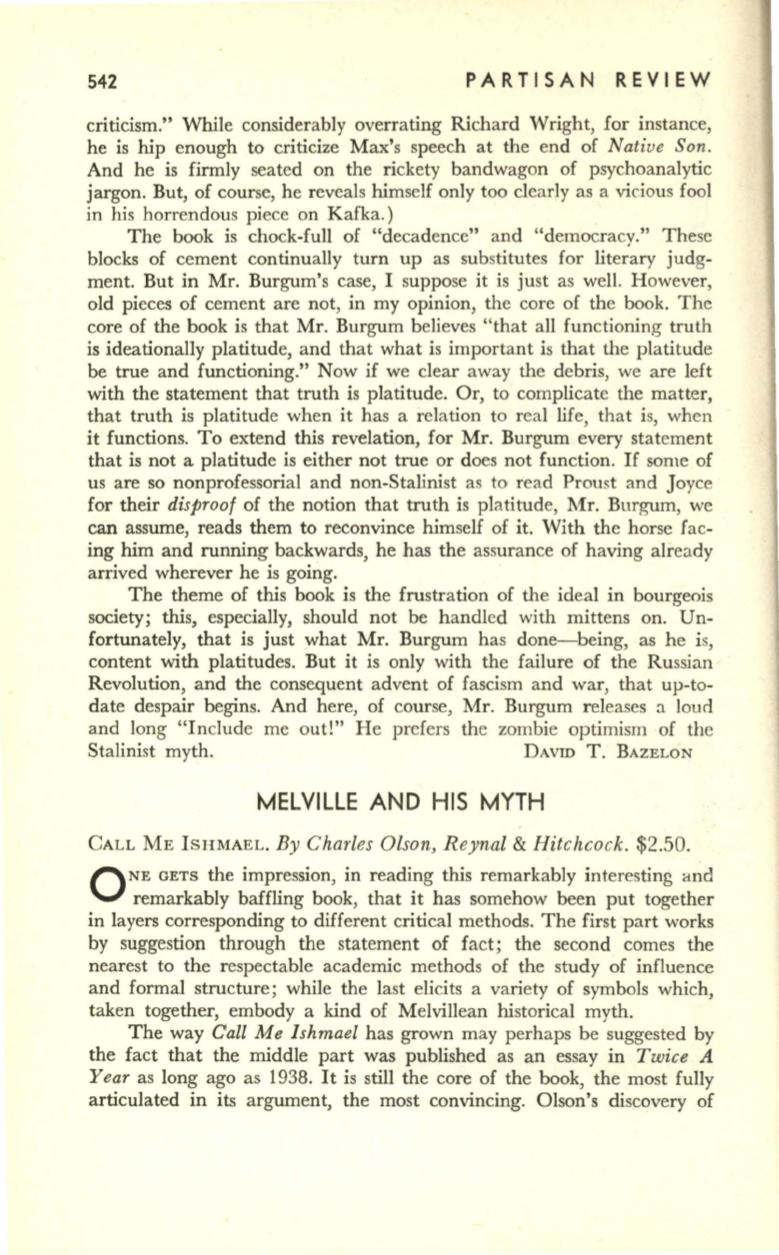
542
PARTISAN REVIEW
criticism." While considerably overrating Richard Wright, for instance,
he is hip enough to criticize Max's speech at the end of
Native Son.
And he is firmly seated on the rickety bandwagon of psychoanalytic
jargon. But, of course, he reveals himself only too clearly as a vicious fool
in his horrendous piece on Kafka.)
The book is chock-full of "decadence" and "democracy." These
blocks of cement continually turn up as substitutes for literary judg–
ment. But in Mr. Burgum's case, I suppose it is just as well. However,
old pieces of cement are not, in my opinion, the core of the book. The
core of the book is that Mr. Burgum believes "that all functioning truth
is ideationally platitude, and that what is important is that the platitude
be true and functioning." Now if we clear away the debris, we are left
with the statement that truth is platitude. Or, to complicate the matter,
that truth is platitude when it has a relation to real life, that is, when
it functions. To extend this revelation, for Mr. Burgum every statement
that is not a platitude is either not true or does not function.
If
some of
us are so nonprofessorial and non-Stalinist as to read Proust and Joyce
for their
disproof
of the notion that truth is platitude, Mr. Burgum, we
can assume, reads them to reconvince himself of it. With the horse fac–
ing
him
and running backwards, he has the assurance of having already
arrived wherever he is going.
The theme of this book is the frustration of the ideal in bourgeois
society; this, especially, should not be handled with mittens on. Un–
fortunately, that is just what Mr. Burgum has done-being, as he is,
content with platitudes. But it is only with the failure of the Russian
Revolution, and the consequent advent of fascism and war, that up-to–
date despair begins. And here, of course, Mr. Burgum releases a loud
and long "Include me out!" He prefers the zombie optimism of the
Stalinist myth.
DAVID T. BAZELON
MELVILLE AND HIS MYTH
CALL ME IsHMAEL.
By
Charles Olson, Reyna[
&
Hitchcock.
$2.50.
O
NE
GETS
the impression, in reading this remarkably interesting and
remarkably baffling book, that it has somehow been put together
in layers corresponding to different critical methods. The first part works
by suggestion through the statement of fact; the second comes the
nearest to the respectable academic methods of the study of influence
and formal structure; while the last elicits a variety of symbols which,
taken together, embody a kind of Melvillean historical myth.
The way
Call Me Ishmael
has grown may perhaps be suggested by
the fact that the middle part was published as an essay in
Twice A
Year
as long ago as 1938. It is still the core of the book, the most fully
articulated in its argument, the most convincing. Olson's discovery of


